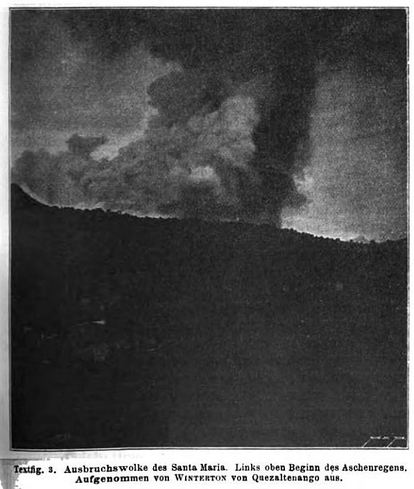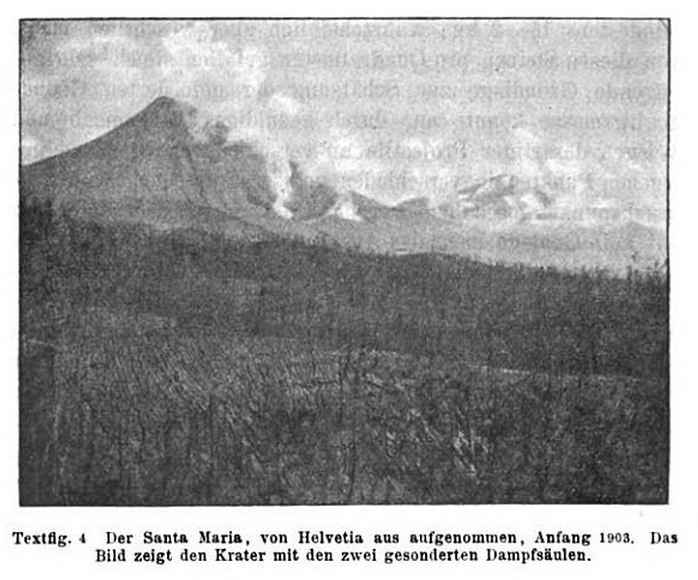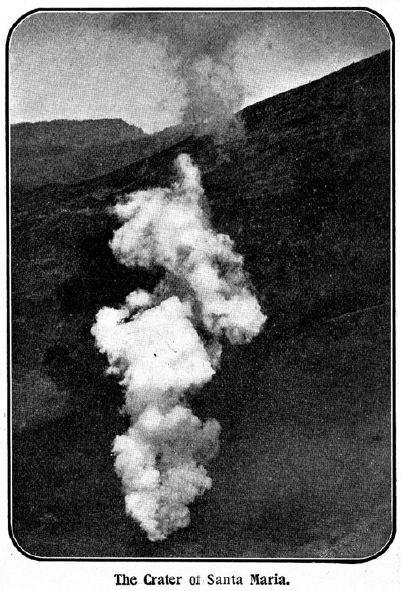20 October 2011
“Translating” descriptions of the 1902 eruption of Santa Maria
Posted by Jessica Ball
I’ve been going through some rather old papers for the background of a manuscript I’m working on, and I’ve been finding that it’s pretty fun to read about volcanic eruptions from the perspective of early twentieth-century geologists (and non-geologists). My field area in Guatemala wasn’t considered active until Volcan Santa Maria suddenly erupted in 1902, so most people who lived there weren’t really familiar with volcanic phenomena. There weren’t any geoscientists who directly observed the eruption , but they made it to the volcano pretty quickly afterward, and collected accounts from local people to supplement their notes.
When I read these accounts, the first time through I imagine what the writers were seeing – and then the second time through I translate the account into modern terminology. One paper that this was particularly useful for is an account of the eruption written by Gustav Eisen, a Swedish PhD in biology/zoology who was living in Guatemala. Dr. Eisen is very descriptive, but to be useful for my current research, his writing needs a little interpretation. Here are some of my favorite passages, and my “translations” of Eisen’s descriptions into current terminology.
“The 24th of October, 1902, at 6:30 in the afternoon, there were suddenly heard all over Guatemala, Salvador, and the southern part of Mexico and Yucatan heavy retumbos, or underground explosions, so common in volcanic countries…they sounded like heavy cannonading…Every explosion caused heavy tremblings of the ground…But even in the immediate vicinity of the volcano these tremblings did not take the form of earthquakes, and no damage was caused from them alone. They occurred after every explosion, and seemed to travel as fast as the explosion itself.”
It’s interesting that Eisen describes retumbos as ‘underground explosions’ – the word also translates as ‘rumblings’ – because it’s pretty clear that the volcano is in full eruption at this point. He also distinguishes the retumbos from the ‘tremblings’ that follow the explosions, and makes sure to mention that they aren’t earthquakes. Possibly he is describing explosions followed by shockwaves, but not sustained earthquakes – and given that the country experienced a devastating earthquake in April of that year, he would probably not make the mistake of confusing the two.
“At midnight, October 24-25, the obscurity caused by the cloud from Santa Maria to Tajumulco became intense, and at about 2 A.M. a fine ash began to fall over the district surrounding Santa Maria. About 9 A.M., on October 25th, the ashes changed into heavy sand of a grayish-white colour, this fall being much heavier in some places than in others…The rain of sand continued for about thirty hours, and was succeeded by a fall of mud.”
The ‘fall of mud’ means that the ash in the eruption plume was getting wet – possibly it was caught up in existing water vapor clouds (this part of Guatemala has a rainy season that lasts into October), or the ash was providing nucleation points for atmospheric moisture and promoting cloud formation on its own. At any rate, this is a perfect situation for forming accretionary lapilli, although the paper doesn’t mention the form of the mud that fell.
“The electric phenomena accompanying the erupton of Santa Maria were most marked. On the 25th of October, from 12 noon to 5 P.M., a sudden and most terrific hurricane swept the vicinity of Santa Maria, extending from several miles southeast of the volcano to several hundred miles west and southwest. During this time lightning struck the ground continually, and, judging from a trip over the country after the eruption had subsided, I am inclined to think that there was not an acre that had not been struck by lightning within the territory swept by the hurricane. How far this extended north and westwards I do not know. But southwards and southwestwards I saw, for fifteen miles from the crater, trees everywhere destroyed by lightning. Branches were twisted and broken, and trunks had fallen to such an extent that progress through the woods was impossible except on foot. While this tremendous hurricane lasted only four hours it did more damage than all the other phenomena of the eruption. It was during this time that most of the mud fell, and that all the trees for a hundred miles to the west of the volcano were stripped of their leaves.”
This is a really fascinating passage. There doesn’t seem to be anyone who observed the crater-forming explosions at Santa Maria, but this description calls to mind the lateral blast that occurred during the 1981 eruption of Mount St. Helens. The fallen tree trunks and twisted branches stripped of their leaves, together with ‘a sudden and most terrific hurricane’ that destroys countryside directly in front of the crater, certainly makes me think of a massive pyroclastic flow or surge. What is interesting is that Eisen says the ‘hurricane’ lasts for four hours – much longer than a single blast could be sustained. Perhaps there was an initial lateral blast followed by other pyroclastic flows or surges from the vertical eruption column.
“The first view of the eruption was on the fourth day, from the hill of Vuelta Grande, and during the night-time. I could then see plainly rising from a smoky sky a dense illuminated cloud, through which flashed lightnings by the dozen in every second. Rising upwards and outwards, in the way water is thrown out of a fountain-jet, there was an almost continuous display of fire balls, which burst and threw out reddish stars.”
Eisen is definitely describing both a Plinian eruption column and the ejection of ballistics – pretty easy to recognize, for anyone who noticed any of the recent eruptions in Iceland.
“Almost every afternoon the rivers rose as much as thirty feet above their former high-water mark, carrying not water, as formerly, but a thick gruel-like mud, consisting of water, sand, ashes, and boulders. The aspect of these terrific torrents sweeping everything before them was something frightful.”
A great description here of lahars, mudflows containing a range of sizes of volcanic material, from fine sediment up to boulders. Eisen goes on to reason that because the area is rainy and there are lots of channels forming in the recent eruption deposits, this material is probably reworked rather than issuing directly from the volcanic vent (despite the earlier mention of a ‘fall of mud’. Spot on!
The 1902 eruption got a lot of press, but the next time that we hear about Santa Maria in accounts like this is in 1929, when part of the Santiaguito lava dome collapsed. I’ll talk about those in another post…
References:
Eisen, G., 1903, “The Earthquake and Volcanic Eruption in Guatemala in 1902”. Bulletin of the American Geographical Society of New York, v. 35, no. 1, p. 325-354.
Sapper, K., 1904, “Die vulkanischen Ereignisse in Mittelamerika in Jahre 1902.” Neues Jahrbuch fur Mineralogie Geologie un Palontologie, v.1, p. 39-90.
Winterton, J., 1903, “The Volcanic Eruptions in Guatemala.” Scientific American, v. 89, no. 5, p. 84.







 Jessica Ball is a volcanologist at the U.S. Geological Survey, researching volcanic hydrothermal systems and stability, and doing science communication for the California Volcano Observatory. She previously worked at the Geological Society of America's Washington DC Policy Office, learning about the intersection of Earth science and legislative affairs. Her Mendenhall postdoc and PhD focused on how water affects the stability of volcanoes, and involved both field investigations and numerical modeling applications. Her blogging covers a range of topics, from her experiences in academic geosciences to science outreach and communication to her field and lab work in volcanology.
Jessica Ball is a volcanologist at the U.S. Geological Survey, researching volcanic hydrothermal systems and stability, and doing science communication for the California Volcano Observatory. She previously worked at the Geological Society of America's Washington DC Policy Office, learning about the intersection of Earth science and legislative affairs. Her Mendenhall postdoc and PhD focused on how water affects the stability of volcanoes, and involved both field investigations and numerical modeling applications. Her blogging covers a range of topics, from her experiences in academic geosciences to science outreach and communication to her field and lab work in volcanology.
Very interesting. A buddy researched tsunami risk in the southwest Pacific, partly via historical documents, back hundreds of years. The first step was getting them translated from Dutch into English. Beyond the scientific value of this work, there were some very interesting anecdotes from spice traders and natives. He had lots of “fun” trying to estimate earthquake intensity from such accounts.
It’s possible that a hurricane, (or the rain band from one) actually hit during this time. If “mud” was falling, then there surely was precipitation.
This part of Central America does get hurricanes, but in this case the damage was far too localized (see the description) to have been a meteorological hurricane. There is no mention of one in NOAA’s records for those dates in 1902 (see http://www.aoml.noaa.gov/hrd/hurdat/1902.htm), and at any rate it isn’t necessary to assume there was a storm involved in producing the “mudfall” – the area around Santa Maria is constantly clouded in and there would have been more than enough moisture available to wet down the ash from the eruption.
The description of the effects (fallen trees, twisted and broken branches, leaves stripped off trees), the localization of those effects adjacent to the eruption crater, and the short duration of the “hurricane” make it very unlikely that there was a real hurricane involved – and much more likely that there was some sort of directed blast from the crater. The area surrounding Mount St. Helens looked quite a bit like this after its eruption in 1980.
So can you convert the other way, and describe a modern eruption as a 19th century observer might see it? If so, that would put you in the perfect position to follow up this book by writing “Sense & Sensibility & Stratovolcanoes”.
I love it! That is an excellent idea for a geologic novel. It will have to be suitable snarky, since the terms “sense” and “sensibility” automatically bring to mind “stay the hell away from the stratovolcano”.
[…] week I talked about “translating” eyewitness accounts of the 1902 eruption of Santa Maria in Guatemala. As all of you probably know by now, the Santiaguito lava dome complex […]
Have you ever looked into similar accounts of Mt. Lassen’s eruptions during the 1910’s? I’m sure there are a few interesting observations to be found.
Not yet, but that’s a good suggestion. I’m not as familiar with California volcanoes as I’d like!
I like the combination of original and new language. I just read some of the original releases the USGS issued about the New Madrid earthquake. Very interesting how people try to explain things they never planned on happening to them. Look forward to reading more from you.
This is a very interesting post. It certainly would be very interesting to find out that there were actually pyroclastic flows or surges associated to the 1902 eruption, but as far as I know, nobody has ever found evidence for such a pyroclastic flow. This is very puzzling and surprising, because being this possibly the second larges explosive eruption in the XX century, the total absence of flows and surges is very unexpected. Maybe no one has looked hard enough for it, and it would maybe worthwhile looking into this to challenge the “standard view” that such phenomena didn’t happen during this eruption.
Now were does that “standard view” come from? Well from many pieces of evidence that don’t show what you would expect, if those flows had happened. Some of the accounts from places that were very close to the crater do not record anything like a pyroclastic flow or surge; not to mention that these people survived and they probably wouldn’t have if a pyroclastic flow or surge would have reached them. The picture of La Sabina that you added shows that trees had lost their foliage and most branches but they were not blown down, which is what you’d expect from a pyroclastic flow or surge. We don’t exactly know where La Sabina was located but it most likely was near to where today Finca La Florida is, and that again is pretty close to the crater. Sapper had the chance to get pretty close to the crater area just a few days after the eruption, and in his many accounts he describes the destruction of the vegetation, but he attributes this to the weight of the tephra on the branches. Being the incredibly prolific and detailed author that he was, I would expect him to describe the kind of devastation more typical of pyroclastic flows and surges if he had encountered it. Of course, because he was so prolific I haven’t read all his accounts and papers, but from what I remember, non of those that I have read describes any of this.
Finally, the area around the vent doesn’t seem to have recorded pyroclastic flows as part of its stratigraphy. From what I’ve seen this stratigraphy includes the pre-1902 paleosol, the 1902 air fall tephra layer, and in some places the 1902 block and ash flow, but nowhere have I seen a pumiceous pyroclastic flow deposits, which is what I would expect to see if there was one associated to the 1902 eruption (but I really haven’t been looking for one in detail). Very close to the crater (immediately north from the current dome comples, on the W flank of the Santa Maria volcano) you can find a very thick tephra layer (more than 10 or 20 m thick) which probably represents the ultraproximal deposit. If a pyroclastic flow or surge was emplaced and preserved in the record this is the place I’d look for it. Maybe for the next field season? I personally would prefer there to be such flows, it would make for a good story!
[…] on Giovanni Arduino, we received one from Jessica Ball at Magma cum Laude, where she discusses the 1902 eruption of Santa Maria. She looks at a particularly descriptive account of the eruption, explaining it in modern […]
i wish i was alive then! i am addicted to sniffing volcanoes, i sniffed mt saint helens, mount etna. they smell yummy!